Portal:Australian roads/Selected article
- Update procedure
- Ensure the content you want to add meets the criteria (see Portal talk:Australian roads#Nominations)
- Add a new selected article summary to the next available subpage, using
{{Transclude lead excerpt|ARTICLE NAME |more=}}- Make sure the length is similar to the other selected article summaries – e.g. use
|paragraphs=1,3to only use the first and third paragraphs. - Add a picture, if available, using
[[File:image name.jpg|right|130x130px|Description of image]](place at the top of the subpage)
- Make sure the length is similar to the other selected article summaries – e.g. use
- Transclude the new subpage below
- Update "max=" to the new total in the {{Random portal component}} template on the main portal page
Selected article
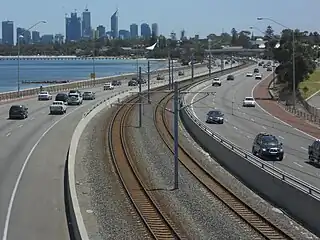
The Kwinana Freeway is a 72-kilometre (45 mi) freeway in and beyond the southern suburbs of Perth, Western Australia, linking central Perth with Mandurah to the south. It is the central section of State Route 2, which continues north as Mitchell Freeway to Clarkson, and south as Forrest Highway towards Bunbury. A 4-kilometre (2.5 mi) section between Canning and Leach highways is also part of National Route 1. Along its route are interchanges with several major roads, including Roe Highway and Mandjoogoordap Drive. The northern terminus of the Kwinana Freeway is at the Narrows Bridge, which crosses the Swan River, and the southern terminus is at Pinjarra Road, east of Mandurah.
Planning for the Kwinana Freeway began in the 1950s, and the first segment in South Perth was constructed between 1956 and 1959. The route has been progressively widened and extended south since then. During the 1980s, the freeway was extended to South Street in Murdoch, and in June 2001, it reached Safety Bay Road in Baldivis. The final extension began as the New Perth Bunbury Highway project, constructed between December 2006 and September 2009. In early 2009, the section north of Pinjarra Road was named as part of the Kwinana Freeway, with the remainder named Forrest Highway. The freeway has been adapted to cater for public transport, with the introduction of bus priority measures in 1987, and the 2007 opening of the Mandurah railway line, constructed in the freeway median strip. (Full article...)
The Mitchell Freeway is a 41.6-kilometre-long (25.8 mi) freeway in the northern suburbs of Perth, Western Australia, linking central Perth with the city of Joondalup. It is the northern section of State Route 2, which continues south as Kwinana Freeway and Forrest Highway. Along its length are interchanges with several major roads, including the Graham Farmer Freeway and Reid Highway. The southern terminus of the Mitchell Freeway is at the Narrows Bridge, which crosses the Swan River, and the northern terminus is at Romeo Road in Alkimos, a suburb within the City of Wanneroo.
Planning for the route began in the 1950s, and the first segment in central Perth was constructed between 1967 and 1973. Named after Sir James Mitchell, the freeway has been progressively extended north since then. In the 1970s, the first two extensions were completed, up to Hutton Street in Osborne Park. By the end of the 1980s, the freeway had reached Ocean Reef Road in Edgewater. The Joondalup railway line was constructed in the freeway median in the early 1990s. This necessitated the relocation of a section of the southbound carriageway, and the construction of three new bridges. In conjunction with these works, additional lanes were constructed in the realigned section.
Since the 1990s, extensions to the Mitchell Freeway have taken it to Romeo Road in Alkimos, which is the freeway's terminus as of July 2023. Further works are planned, which will eventually take the freeway past Yanchep and Two Rocks to the boundary of the Perth Metropolitan Region. (Full article...)
Tonkin Highway is an 81-kilometre-long (50 mi) north–south highway and partial freeway in Perth, Western Australia, linking Perth Airport and Kewdale with the city's north-eastern and south-eastern suburbs. As of April 2020, the northern terminus is at the interchange with Brand Highway and Great Northern Highway in Muchea, and the southern terminus is at Thomas Road in Oakford. It forms the entire length of State Route 4, and connects to several major roads. Besides Brand Highway and Great Northern Highway, it also connects to Reid Highway, Great Eastern Highway, Leach Highway, Roe Highway, and Albany Highway.
Planning for the route began in the 1950s, but the first segment between Wattle Grove and Cloverdale was not opened until 1980. Over the next five years, the highway was extended north to Great Eastern Highway and south to Albany Highway, and a discontinuous section was constructed north of the Swan River. In 1988 the Redcliffe Bridge linked these sections, and three years later, Reid Highway became the northern terminus. The next major works on the highway, between 2003 and 2005, extended the highway south to Thomas Road.
The central section of Tonkin Highway was upgraded to a six-lane freeway-standard road between 2013 and 2015, as part of the Gateway WA project to improve the wider road network around Perth Airport. From 2016 to 2020, construction commenced to upgrade the section of Tonkin Highway between Guildford Road and the original Reid Highway terminus to a six-lane freeway-standard road, and to build a four-lane freeway standard road up to Muchea, as part of the NorthLink WA project. The extension was originally known as the Perth Darwin National Highway. Planning provisions have been made for Tonkin Highway to be extended south of Byford in the future. (Full article...)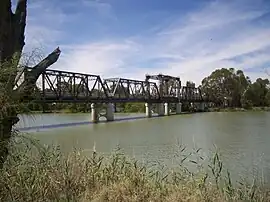
Abbotsford Bridge is a steel Allan truss-type road bridge that carries the Silver City Highway across the Murray River, between Curlwaa in New South Wales, and Yelta in Victoria, Australia. It is the only remaining steel truss bridge with a lift span that crosses the Murray. Opened in 1928, the bridge was built by the NSW Department of Public Works and was designed by Percy Allan. It was the second last vertical-lift bridge to be built over the river, the last being the Nyah Bridge, which opened in 1941.
The bridge was constructed over a three-year period from 1925. The project was not originally planned to take as long, but there were delays due to problems with a contractor, and industrial action. The bridge was designed to carry the Mildura railway line over the Murray River and into New South Wales, to service significant cross-border traffic arising from the fruit-growing industry, but the line was never extended beyond the terminus at Yelta. The bridge currently carries a single lane of road controlled by traffic lights.
In 1931, there was a major accident at the bridge when a paddle steamer clipped the lift span, tearing apart the upper deck of the boat. (Full article...)
Majura Parkway is a 11.5-kilometre-long (7.1 mi) north–south parkway located in the Majura district of the Australian Capital Territory (ACT). It links the interchange with Federal Highway and Horse Park Drive at the edge of Gungahlin district to Monaro Highway in Fyshwick.
The parkway had been in planning since the 1970s and is considered an important access road to and from the Gungahlin district. The parkway provides a more efficient transport link in the area and conveys a large numbers of freight vehicles. The project was jointly funded by the ACT and Australian Governments, at a total cost of A$288 million. (Full article...)
The Causeway is an arterial traffic crossing in Perth, Western Australia, linking the inner-city suburbs of East Perth and Victoria Park. It is carried over the Swan River at the eastern end of Perth Water by two bridges on either side of Heirisson Island. The current Causeway is the third structure to have been built across the river at this point.
Originally the site of mudflats which restricted river navigation, the Colony Government constructed a causeway and bridge across the site. The project was first planned in 1834 and opened in 1843. When floods in 1862 almost destroyed it, the structure was rebuilt using convict labour, and raised to better withstand future floods. Governor John Hampton officially opened the new Causeway on 12 November 1867. Over the following decades, the three bridges making up this second Causeway were widened several times, and they were eventually replaced in 1952.
The current Causeway bridges were designed by E W C Godfrey, and built between 1947 and 1952. They were the first in Western Australia to use steel composite construction. Large roundabouts were also constructed at each end of the structure, to improve the flow of traffic. The opening of the Graham Farmer Freeway in 2000 reduced the traffic volume on the Causeway, allowing the two central lanes to be turned into bus lanes. By the early 2000s, the concrete structures had suffered significant damage. Cracks were repaired using carbon fibre reinforcement and localised patching, extending the bridge's life by decades. The Causeway bridges have been recognised for their heritage value by their entry on the Western Australian Register of Heritage Places. (Full article...)
The Canning Stock Route is a track that runs from Halls Creek in the Kimberley region of Western Australia to Wiluna in the mid-west region. With a total distance of around 1,850 km (1,150 mi) it is the longest historic stock route in the world.
The stock route was proposed as a way of breaking a monopoly that west Kimberley cattlemen had on the beef trade at the beginning of the 20th century. In 1906, the Government of Western Australia appointed Alfred Canning to survey the route. When the survey party returned to Perth, Canning's treatment of Aboriginal guides came under scrutiny leading to a Royal Commission. Canning had been organising Aboriginal hunts to show the explorer where the waterholes were. Despite condemning Canning's methods, the Royal Commission, after the Lord Mayor of Perth, Alexander Forrest had appeared as a witness for Canning, exonerated Canning and his men of all charges. The cook who made the complaints was dismissed and Canning was sent back to finish the job.
Canning was appointed to lead a construction party and between March 1908 and April 1910, 48 wells were completed along the route. Commercial droving began in 1910, but the stock route did not prove popular and was rarely used for the next twenty years. The wells made it difficult for Aboriginal people to access water and in reprisal they vandalised or dismantled many of the wells.
A 1928 Royal Commission into the price of beef in Western Australia led to the repair of the wells and the re-opening of the stock route. Around 20 droves took place between 1931 and 1959 when the final droving run was completed. (Full article...)
The Houghton Highway is a 2.74 km (1.70 mi) reinforced concrete viaduct, the second bridge to be built across Hays Inlet at Bramble Bay connecting the cities of Redcliffe and Brisbane in Queensland, Australia (the first bridge was the Hornibrook Bridge). The bridge, along with the third bridge, the Ted Smout Memorial Bridge, were the longest bridges in the country until 27 March 2013, when the Macleay River Bridge opened in Kempsey, NSW.
Originally built to duplicate the crossing capacity, almost immediately after opening it was converted to a three lane roadway with 'peak flow' lane control as a result of the proposed upgrading of the Hornibrook Bridge being deemed uneconomic. The intended crossing capacity was finally provided with the opening of the Ted Smout Memorial Bridge in 2010. (Full article...)
Jeffrey Street or Jeffreys Street is a street located in Kirribilli, famous for being one of the most popular vantage points for views of the city skyline of Sydney, the Sydney Harbour Bridge and the Sydney Opera House. The street is located on the Lower North Shore of Sydney Harbour, directly across the harbour from Circular Quay and is a popular destination for tourists, particularly on Australia Day and New Year's Eve. The street leads uphill from the harbour in a northerly direction to the small shopping village of Kirribilli. For many years the area was called the North Shore and the original land grant changed hands a number of times. Over the past 200 years the area has also been called Huntershill, St Leonards, North Sydney, "Kiarabilli", Milsons Point and "Kirribilli Point". The modern spelling Kirribilli was first used in 1853 and the use of Kirribilli as a locality is more recent.
There are 19 listed heritage properties along the street, one of the highest concentrations of listed heritage properties in Australia. All but one of the original structures on the east side of the street have been demolished, only "Wyalla" remains. But the west side of Jeffrey Street is notable because it contains a row of 17 terrace houses that have remained virtually unchanged for over 100 years. This is the longest row remaining on Sydney's North Shore and the second longest row in Australia. Most of the other terrace houses in the area were demolished in order to construct the approaches to the Sydney Harbour Bridge. (Full article...)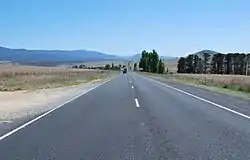

Snowy Mountains Highway is a 333-kilometre-long (207 mi) state highway located in New South Wales, Australia. Its two sections connect the New South Wales South Coast to the Monaro region, and the Monaro to the South West Slopes via the Snowy Mountains. The higher altitude regions of this road are subject to snow over the winter months, and the road also provides access to many parts of the Snowy Mountains Scheme. The highway bears the B72 shield along its entire length.
The highway originally bore the name Monaro Highway until 1958, when it received its current name. It originally ran from Tathra to Wagga Wagga but has been shortened to run from Princes Highway to Hume Highway instead. Part of the roadway was reallocated to what is now known as Monaro Highway in 1955. Reservoirs created as a result of dams built in the 1950s and 1960s as part of the Snowy Mountains Scheme required the creation of major realignments to avoid submerged areas. Previous to New South Wales' conversion to alphanumeric route markers, it was signed as National Route 18. (Full article...)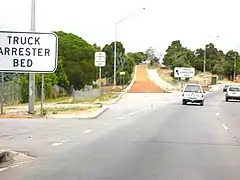
Great Eastern Highway is a 590-kilometre-long (370 mi) road that links the Western Australian capital of Perth with the city of Kalgoorlie. A key route for road vehicles accessing the eastern Wheatbelt and the Goldfields, it is the western portion of the main road link between Perth and the eastern states of Australia. The highway forms the majority of National Highway 94, although the alignment through the Perth suburbs of Guildford and Midland, and the eastern section between Coolgardie and Kalgoorlie are not included. Various segments form parts of other road routes, including National Route 1, Alternative National Route 94, and State Route 51.
The highway was created in the 1930s from an existing system of roads linking Perth with the Goldfields. Though the name Great Eastern Highway was coined to describe the route from Perth to Guildford on the northern side of the Swan River (modern-day Guildford Road), it was actually used for the road through Belmont, south of the river. This section was constructed in 1867 using convict labour, with the road base made from sections of tree trunks. Over the years the road has been upgraded, with the whole highway sealed by 1953, segments reconstructed and widened, dual carriageways created in Perth and Kalgoorlie, and grade separated interchanges built at major intersections. Great Eastern Highway Bypass in Perth's eastern suburbs opened in 1988, allowing through traffic to avoid the Guildford and Midland townsites, and in 2002 a new bypass diverted the highway around Northam. A future route to replace Great Eastern Highway's current ascent of the Darling Scarp has been identified. The planned route is a controlled-access highway along Toodyay Road to Gidgegannup, and then across to Wundowie via a new alignment. Though planning began in the 1970s, , construction of this route has not been scheduled, and it is not considered a priority. (Full article...)Forrest Highway is a 95-kilometre-long (59 mi) highway in Western Australia's Peel and South West regions, extending Perth's Kwinana Freeway from east of Mandurah down to Bunbury. Old Coast Road was the original Mandurah–Bunbury route, dating back to the 1840s. Part of that road, and the Australind Bypass around Australind and Eaton, were subsumed by Forrest Highway. The highway begins at Kwinana Freeway's southern terminus in Ravenswood, continues around the Peel Inlet to Lake Clifton, and heads south to finish at Bunbury's Eelup Roundabout. There are a number of at-grade intersections with minor roads in the shires of Murray, Waroona, and Harvey including Greenlands Road and Old Bunbury Road, both of which connect to South Western Highway near Pinjarra.
Since the 1980s, the state government has been upgrading the main Perth to Bunbury route, by extending Kwinana Freeway south from Perth, and constructing a dual carriageway on Old Coast Road north of Bunbury, including bypasses around Australind and Dawesville. A bypass was also planned around Mandurah, which underwent detailed environmental reviews and assessments in the 1990s and early 2000s. Construction of the New Perth Bunbury Highway project, which became Forrest Highway and the final Kwinana Freeway extension, began in December 2006, and the new highway was opened on 20 September 2009. In June 2014, Forrest Highway was extended south to Bunbury by renaming much of Old Coast Road as well as Australind Bypass as part of the highway. (Full article...)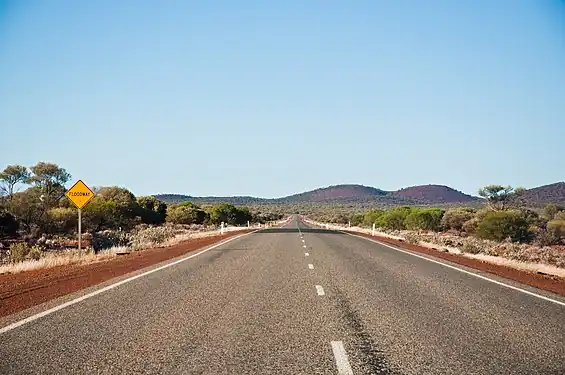
Great Northern Highway is an Australian highway that links Western Australia's capital city Perth with its northernmost port, Wyndham. With a length of almost 3,200 kilometres (2,000 mi), it is the longest highway in Australia, with the majority included as part of the Perth Darwin National Highway. The highway is constructed as a sealed, predominantly two-lane single carriageway, but with some single-lane bridges in the Kimberley. The Great Northern Highway travels through remote areas of the state, and is the only sealed road link between the Northern Territory and northern Western Australia. Economically, it provides vital access through the Wheatbelt and Mid West to the resource-rich regions of the Pilbara and Kimberley. In these areas, the key industries of mining, agriculture and pastoral stations, and tourism are all dependent on the highway.
The highway was created in 1944 from existing roads in the Wheatbelt and a series of tracks through remote pastoral areas. However, it was a hazardous route that could be dusty in the dry season, and boggy or washed away in the wet season. Some sections were effectively impassable sand, while others contained limestone outcrops. Economic growth and development in northern Western Australia prompted initial improvement efforts, and the federal government's Beef Roads Scheme in the 1960s resulted in a noticeably higher-quality road in the Kimberley. Construction of a sealed road from Perth to Wyndham, including numerous bridges to reduce the impact of seasonal flooding, took many years to complete. The last section opened on 16 December 1989, and received national media coverage. However, by then many older sections were either worn out or not up to modern standards. Various upgrades have been carried out in small sections, across the length of the highway, with further works planned. The southernmost part of the highway, from Midland to Muchea, was bypassed in 2020 by the NorthLink WA project that upgraded and extended the Tonkin Highway to Muchea. This section remains in use for local traffic and tourism to the Swan Valley area. (Full article...)